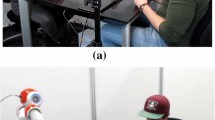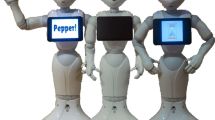Abstract
This paper describes a hands-off socially assistive therapist robot designed to monitor, assist, encourage, and socially interact with post-stroke users engaged in rehabilitation exercises. We investigate the role of the robot’s personality in the hands-off therapy process, focusing on the relationship between the level of extroversion–introversion of the robot and the user. We also demonstrate a behavior adaptation system capable of adjusting its social interaction parameters (e.g., interaction distances/proxemics, speed, and vocal content) toward customized post-stroke rehabilitation therapy based on the user’s personality traits and task performance. Three validation experiment sets are described. The first maps the user’s extroversion–introversion personality dimension to a spectrum of robot therapy styles that range from challenging to nurturing. The second and the third experiments adjust the personality matching dynamically to adapt the robot’s therapy styles based on user personality and performance. The reported results provide first evidence for user preference for personality matching in the assistive domain and demonstrate how the socially assistive robot’s autonomous behavior adaptation to the user’s personality can result in improved human task performance.
Similar content being viewed by others
References
Aigner P, McCarragher B (1998) Shared control framework applied to a robotic aid for the blind. In: Proceedings of the IEEE international conference on robotics and automation (ICRA’98), Leuven, Belgium, pp 712–722
Apple W, Streeter LA and Krauss RM (1979). Effects of pitch and speech rate on personal attributions. J Personal Soc Psychol 37: 715–727
Bandura A (1969). Principles of behavior modification. Holt, Rinehart & Wilson, New York
Berlin M, Gray J, Thomaz AL, Breazeal C (2006) Perspective taking: an organizing principle for learning in human–robot interaction. In: Proceedings of the 21st national conference on artificial intelligence (AAAI)
Brewer BR, Klatzky R and Matsuoka Y (2003). Feedback distortion to overcome learned nonuse: a system overview. IEEE Eng Med Biol 3: 1613–1616
Brown B, Strong W and Rencher A (1975). Acoustic determinants of the perceptions of personality from speech. Int J Sociol Language 6: 11–32
Burgar CG, Lum PS, Shor PC and Loos MV (2000). Development of robots for rehabilitation therapy: the palo alto va/stanford experience. J Rehabil Res Develop 37(6): 639–652
Christensen H and Pacchierotti E (2005). Embodied social interaction for robots. In: Dautenhahn, K (eds) Artificial intelligence and simulation of behavior convention (AISB’05)., pp 40–45. Hertsfordshire, UK
DiCaprio NS (1983). Personality theories: a guide to human nature. Holt, Rinehart & Wilson, New York
Eriksson J, Matarić MJ, Winstein C (2005) Hands-off assistive robotics for post-stroke arm rehabilitation. In: Proceedings of the IEEE international conference on rehabilitation robotics (ICORR’05), Chicago, IL, USA, pp 21–24
Ewen RB (2003) An introduction to theories of personality. Lawrence Erlbaum Associates
Eysenck HJ (1953). The structure of human personality. Methuen, London
Eysenck HJ (1991). Dimensions of personality: 16, 5 or 3? criteria for a taxonomic paradigm. Personal Individ Diff 12: 773–790
Eysenck HJ and Eysenck SB (1968). Manual: Eysenck Personality Inventory. Educational and Industrial Testing Service, San Diego, USA
Feil-Seifer D, Matarić MJ (2005) Defining socially assistive robotics. In: Proceedings of the IEEE international conference on rehabilitation robotics (ICORR’05), Chicago, IL, USA, pp~465–468
Ghahramanlou M, Arnoff J, Wozniak MA, Kittner SJ, Price TR (2001) Personality influences psychological adjustment and recovery from stroke. In: Proceedings of the American Stroke Association’s 26th international stroke conference, Fort Lauderdale, USA
Gockley R, Matarić MJ (2006) Encouraging physical therapy compliance with a hands-off mobile robot. In: Proceedings of the first international conference on human–robot interaction (HRI’06), Salt Lake City, USA, pp 150–155
Goetz J, Kiesler S (2002) Cooperation with a robotic assistant. In: Proceedings of the international conference on computer–human interaction (CHI’02), Minneapolis, Minnesota, USA, pp 578–579
Hall ET (1966). Hidden dimension. Doubleday, Gordon City
Harkins S, Becker LA and Stonner D (1975). Extraversion-introversion and the effects of favorability and set size on impression formation. Bull Psychonomic Soc 5: 300–302
Harwin WS, Ginige A and Jackson RD (1988). A robot workstation for use in education of the physically handicapped. IEEE Trans Biomed Eng 35(2): 127–131
Kohl N, Stone P (2004) Policy gradient reinforcement learning for fast quadrupedal locomotion. In: Proceedings of the IEEE international conference on robotics and automation (ICRA’04), New Orleans, USA, vol 3, pp 2619–2624
Krebs HI, Volpe BT, Ferraro M, Fasoli S, Palazzolo J, Rohrer B, Edelstein L and Hogan N (2002). Robot-aided neurorehabilitation: from evidence-based to science-based rehabilitation. Top Stroke Rehabil 8(4): 54–70
Levine SL, Bell D, Jaros L, Simpson R, Koren Y and Borenstein J (1999). The navchair assistive wheelchair navigation system. IEEE Trans Rehabil Eng 7(4): 443–451
McCarthy C, Pollack M (2002) A plan-based personalized cognitive orthotic. In: Proceedings of the 6th international conference on AI planning and scheduling, Toulouse, France
McCrae R, Costa P (1996) Toward a new generation of personality theories: theoretical contexts for the five factor model. The five factor model of personality: Theoretical perspectives, pp 51–87
Michaud F, Clavet A (2001) Robotoy contest—designing mobile robotic toys for autistic children. In: Proceedings of the American Society for engineering education (ASEE’01), Alberqueque, NM, USA
Michaud F, Laplante JF, Larouche H, Duquette A, Caron S, Masson P (2005) Asutonomous spherical mobile robot to study child development. IEEE Trans Syst Man Cybern 35(4):471–480
Michaud F, Salter T, Duquette A, Laplante JF (2007) Perspectives on mobile robots used as tools for pediatric rehabilitation. Assist Technol 19:14–29
Michaud F and Theberge-Turmel C (2002). Mobile robotic toys and autism. In: Billard, A, Dautenhahn, K, Canamero, L and Edmonds, B (eds) Socially intelligent agents—creating relationships with computers and robots., pp. Kluwer Academic Publishers, New York
Miller N, Jenkins O, Kallmann M, Drumwright E, Matarić MJ (2004) Motion capture from inertial sensing for untethered humanoid teleoperation. In: Proceedings of the IEEE-RAS international conference on humanoid robotics (Humanoids-2004), Santa Monica, CA, USA
Montemerlo M, Pineau J, Roy N, Thrun S, Verma V (2002) Experiences with a mobile robotics guide for the elderly. In: Proceedings of the 18th AAAI national conference on artificial intelligence, Edmonton, Alberta, Canada, pp 587–592
Morris LW (1979). Extraversion and introversion: an interactional perspective. Hemisphere, Washington, DC
Murray JB (1990). Review of research on the myers-briggs type indicator. Percept Motor Skills 70: 1187–1202
Nakajima H, Morishima Y, Yamada R, Brave S, Maldonado H, Nass C and Kawaji S (2004). Social intelligence in a human-machine collaboration system: Social responses to agents with mind model and personality. J Jpn Soc Artif Intell 19(3): 184–196
Nakajima H, Nass SBC, Yamada R, Morishima Y, Kawaji S (2003) The functionality of human–machine collaboration systems mind model and social behavior. In: Proceedings of the IEEE conference on systems, man, and cybernetics, Washington, USA, pp 2381–2387
Nass C and Lee MK (2001). Does computer-synthesized speech manifest personality? experimental tests of recognition, similarity-attraction and consistency-attraction. J Exp Psychol Appl 7(3): 171–181
National Institute of Neurological Disorders and Stroke: Post-Stroke Rehabilitation Fact Sheet (2006)
Nicolescu M, Matarić MJ (2001) Learning and interacting in human–robot domains. IEEE Trans Syst Man Cybernet special issue on Socially Intelligent Agents—The Human in the Loop
Pittman J (1994). Voice in social interaction: an interdisciplinary approach. Sage, Thousand Oaks
Plaisant C, Druin A, Lathan C, Dakhane K, Edwards K, Vice JM, Montemayor J (2000) A storytelling robot for pediatric rehabilitation. In: Proceedings of the 4th ACM/SIGCAPH conference on assistive technologies (ASSETS’00), Washington, DC, USA, pp 50–55
Reinkensmeyer DJ, Pang CT, Nesseler JA and Painter CC (2002). Web-based tele-rehabilitation of the upper extremity after stroke. IEEE Trans Neural Syst Rehabil Eng 10(2): 102–108
Robins B, Dautenhahn K, te Boekhorst R, Billard A (2005) Robotic assistants in therapy and education of children with autism: can a small humanoid robot help encourage social interaction skills? Universal Access in the Information Society (UAIS)
Roy N, Baltus G, Fox D, Gemperle F, Goetz J, Hirsch T, Magaritis D, Montemerlo M, Pineau J, Schulte J, Thrun S (2000) Towards personal service robots for the elderly. In: Proceedings of the workshop on interactive robots and entertainment, Pittsburgh, PA, USA
Scassellatti B (2005) How social robots will help us to diagnose, treat and understand autism. In: Proceedings of the 12th international symposium of robotics research (ISSR’05), San Francisco, CA, USA
Scassellatti B (2005) Quantitative metrics of social response for autism diagnosis. In: Proceedings of the 14th IEEE international workshop on robot and human interactive communication (RO-MAN’05), Nashville, USA
Simpson R, Levine S (1997) Development and evaluation of voice control for a smart wheelchair. In: Proceedings of the rehabilitation engineering society of North America annual conference, Washington, DC, USA, pp 417–419
Singh S, Barto AG, Chentanez N (2005) Intrinsically motivated reinforcement learning. In: Proceedings of the advances in neural information processing systems 17 (NIPS), Vancouver, Canada
Steven D, Frank G, Sara G, Hisamitsu K, Adam S, Haoyong Y, Long Y (2000) Pamm - a robotic aid to the elderly for mobility assistance and monitoring. In: Proceedings of the IEEE international conference on robotics and automation ICRA’00, San Francisco, CA, USA, pp 570–576
Stiehl WD, Lieberman J, Breazeal C, Basel L, Cooper R, Knight H, Lalla L, Maymin A, Purchase S (2006) The huggable: a therapeutic robotic companion for relational, affective touch. In: Proceedings of the IEEE consumer communications and networking conference, Las Vegas, NV, USA
Sutton R, McAllester D, Singh S and Mansour Y (2000). Policy gradient methods for reinforcement learning with function approximation. Adv Neural Informat Process Syst 12: 1057–1063
Tapus A and Matarić MJ (2006). Towards socially assistive robotics. Int J Robotics Soc Jpn (JRSJ) 24(5): 14–16
Trouvain J, Barry WJ (2000) The prosody of excitement in horse race commentaires. In: Proceedings of the ISCA—Workshop on speech and emotion, Newcastle, Northern Ireland, pp 86–91
Tusing KJ and Dillard JP (2000). The sounds of dominance: Vocal precursors of perceived dominance during interpersonal influence. Human Commun Res 26(1): 148–171
Wada J, Shibata T, Saito T, Tanie K (2000) Analysis of factors that bring mental effects to elderly people in robot assisted activity. In: Proceedings of the IEEE/RSJ international conference on intelligent robots and systems (IROS’02), Lausanne, Switzerland, pp 1152–1157
Walters ML, Dautenhahn K, Koay KL, Kaouri C, Boekhorst R, Nehaniv C, Werry I, Lee D (2005) Close encounters: spatial distances between people and a robot of mechanistic appearance. In: Proceedings of the IEEE-RAS international conference on humanoid robots (Humanoids’05), Tsukuba International Congress Center, Tsukuba, Japan, pp 450–455
Walton M (2003) Meet paro, the therapeutic robot seal. In: CNN
Woods S, Dautenhahn K, Kaouri C, Boekhorst R, Koay KL (2005) Is this robot like me? links between human and robot personality traits. In: Proceedings of the IEEE-RAS international conference on humanoid robots (Humanoids’05), Tsukuba International Congress Center, Tsukuba, Japan, pp 375–380
Yanco H (2002) Evaluating the performance of assistive robotic systems. In: Proceedings of the workshop on performance metrics for intelligent systems. Gaithersburg, MD, USA
Author information
Authors and Affiliations
Corresponding author
Additional information
This work was supported by USC Women in Science and Engineering (WiSE) Program and the Okawa Foundation.
Rights and permissions
About this article
Cite this article
Tapus, A., Ţăpuş, C. & Matarić, M.J. User—robot personality matching and assistive robot behavior adaptation for post-stroke rehabilitation therapy. Intel Serv Robotics 1, 169–183 (2008). https://doi.org/10.1007/s11370-008-0017-4
Received:
Accepted:
Published:
Issue Date:
DOI: https://doi.org/10.1007/s11370-008-0017-4




